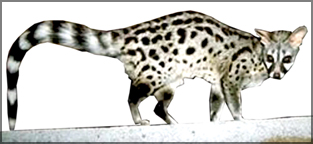

Like the binturong, (we featured last weekt) he genet too belongs to
the family of Viverridae and is related to civets and linsangs.
 |
|
Spotted genet |
 About
eleven species are known and except for the common genet, the rest of
the species are exclusively found in Africa. The common genet inhabits
Northwest Africa and is widespread in Europe, parts of Middle East and
the Balearic Islands. About
eleven species are known and except for the common genet, the rest of
the species are exclusively found in Africa. The common genet inhabits
Northwest Africa and is widespread in Europe, parts of Middle East and
the Balearic Islands.
This superficially cat-like creature, despite its resemblance to the
cat, is only a distant relative of the cat. But like the domesticated
cat, the genetís popularity as a pet, especially the common genet and
the large-spotted genet, is increasing by the day. One of the main
reasons itís kept as a pet is its curious and playful nature which is
similar to that of a kitten, or a domesticated ferret.
If a genet is taken in as a pet when itís very small, it will form a
strong bond with its human owner. It could be carried and petted. But,
if it doesnít like to be restrained at any particular time, itís
virtually impossible to hold it or carry it.
Even if you try to hold on to it by its skin, the genet would try to
turn its skin around and escape. Normally it is an inquisitive creature,
but its extremely cautious too.
  When
startled, it darts for cover and sometimes creeps into holes or crevices
that are hard for both humans and animals to reach. Even long time pet
genets do this when they are frightened. When
startled, it darts for cover and sometimes creeps into holes or crevices
that are hard for both humans and animals to reach. Even long time pet
genets do this when they are frightened.
The genet can creep into small places you may never expect it to go;
with its slender and supple body, it can squeeze into any opening large
enough for its head to pass through. It is known to bite when cornered
or frightened, but not as a means of attack.
Like its cousin, the civet, the genet too has strong musk glands
which it uses mainly to mark its territories. In order to spray-mark its
territory, the highly agile genet does a hand-stand. It is the only
member of the Viverridae family known to stand bipedally.
Well, by looking at the pictures you can see what its physical
appearance is like. According to recorded data, in general the genetís
coat (which could differ in colour from species to species), is marked
with spots.
The long tail is banded though some species might have uniform
coloured tails. About 20 inches in length and weighing around 4-5
pounds, the genet has large, round eyes and a small head with triangular
shaped large ears.
  The
body is slender and long, but legs are rather short. Both front and hind
legs have five digits and well furred soles. When frightened it springs
up a mane of hair along its back. The
body is slender and long, but legs are rather short. Both front and hind
legs have five digits and well furred soles. When frightened it springs
up a mane of hair along its back.
The genet has semi-retractable (could be partly taken back) claws,
but it does not use them as weapons when fighting its enemies. Instead
they are used exclusively for climbing trees and holding down prey while
it administers a bite on the neck.
Even though the genet is known to be nocturnal it has been spotted
even during day time in varying seasons. It is also classified as an
arboreal (tree dwelling) animal, but when hunting for prey it spends
time on the ground. It climbs trees to hunt nesting or roosting birds.
The genet s a solitary animal and does not socialise with other
genets except during the breeding season or when with young. A female
gives birth to between two to four kittens, twice a year.
The young are born in a burrow. The eyes and ears are shut at birth
and open only after 10 days. They are introduced to solids at six weeks,
even though they are nursed by the mother for much longer. Maturity is
reached at two years.
Some researchers class the genet as a carnivorous animal despite
studies showing the animalís tendency to eat what is available when food
is scarce. Its diet therefore includes various fruits, small mammals
like bats, rodents and squirrels, birds and their eggs, frogs, milli/centipedes
and even scorpions.
Would you believe that this cat-like animal, though not a true cat,
makes sounds similar to those of a cat? It can mew and purr and also
hiss and spit. However when distressed it makes a churning sound which
is not cat-like at all!
 |
| Two hand made images of
Rusty spotted genet(above) and Abyssinian genet(left). |
The 11 species of genets include the Abyssinian genet, Angolan genet,
Common genet, Panther genet, Aquatic genet, Servaline genet, Pardine
genet, Large spotted genet and Giant genet. The Crested genet is
believed to be a subspecies of the Servaline by some researchers.
The Angolan genet has reddish grey to dark grey fur with small
brownish black spots on its body and stripes on its tail which is more
thickly furred than in other genets.The muzzle or snout is black with a
white line around the eyes and mouth.
It has a dark stripe on the dorsal starting from the base of the
skull up to the tail. About five rows of elongated spots or stripes run
down the side of the neck. Melanistic (completely black) individuals are
also known to exist in this species.
The spinal mane is about two inches in length. The Angolan weighs
between 2.2-4.4 lbs (1.2 kg).The Common genet (the most far ranging
among the 11 species) which is also known as the European genet or Small
spotted genet has a pale grey and black spotted coat, when an adult,
while as a juvenile it has a darker coat.
According to researchers there are about 30 subspecies of the Common
genet. The Panther genet, also known as the Rusty-spotted genet and
Forest genet, is reported to be widespread throughout the sub-saharan
Africa and is primarily a fruigivore (fruit eating).
The Large spotted genet which is very similar to the Common genet is
said to have yellow white or grey coloured coat with rust or black
coloured rossetís and black and white rings as the tail. It is also
known as the Rusty spotted genet.
The Aquatic genet is very striking with a plain rusty to red coloured
coat, black tail and white elongated spots between its eyes.
 It
feeds primarily on fish which it attracts by gently tapping the surface
of the water in the streams found in the rainforests it inhabits. It
places its whiskers against the surface of the water to detect the
movement of fish underwater and dives in, the moment it detects the
prey. It
feeds primarily on fish which it attracts by gently tapping the surface
of the water in the streams found in the rainforests it inhabits. It
places its whiskers against the surface of the water to detect the
movement of fish underwater and dives in, the moment it detects the
prey.
But strangely itís not a good swimmer. This carnivorous genet is
found mostly in north-east Zaire. |

